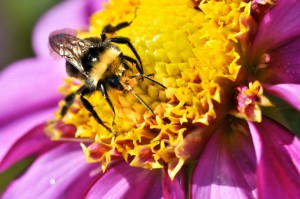 With nature’s most proficient pollinators – bees – dying out in startling numbers in the past few years, there’s a newfound appreciation for bees and a much needed sense of urgency to bring an end to the ominous decline of the bee population. Want to help out bees? You need only make a few adjustments to make your garden bee-friendly. Everyone knows bees can be a gardener’s best friends – so return the favor by doing what you can to provide a safe and nuturing place for them. Plant pollinator friendly plants Plants with flowers that produce high quantities of pollen and nectar will provide food for beneficial bees (and other pollinators) and are a prerequisite for a bee-friendly garden. Raspberries, blackberries, sunflowers, alliums, lilacs… there’s a vast variety to choose from. Native plants tend to produce more pollen than non-native plants, so include some wildflowers in your garden. Find a bee-friendly flower mix to provide variety and lots of pollen for your neighborhood bees. Plan your plantings in such a manner that something’s in bloom at all times and the bees have a steady food supply irrespective of the time of the year. Keep water available Bees need to drink. Put out a shallow container with some pebbles and twigs where bees can land and take a sip. Avoid use of harmful chemicals Widespread use of harmful pesticides is one of the primary causes of the demise of bees. Opt for environmentally benign products for your pest control so you don’t negatively impact your bee population. Provide for nesting space We’ve all panicked at the sight of bees building a nest in and around our homes at some point, and driven them off. But global urbanization has robbed bees of natural nesting sites and it’s real hard for them to find suitable, secure sites to nest. You can help by leaving some sunlit space uncultivated – some species nest in tall grass or decaying wood.
With nature’s most proficient pollinators – bees – dying out in startling numbers in the past few years, there’s a newfound appreciation for bees and a much needed sense of urgency to bring an end to the ominous decline of the bee population. Want to help out bees? You need only make a few adjustments to make your garden bee-friendly. Everyone knows bees can be a gardener’s best friends – so return the favor by doing what you can to provide a safe and nuturing place for them. Plant pollinator friendly plants Plants with flowers that produce high quantities of pollen and nectar will provide food for beneficial bees (and other pollinators) and are a prerequisite for a bee-friendly garden. Raspberries, blackberries, sunflowers, alliums, lilacs… there’s a vast variety to choose from. Native plants tend to produce more pollen than non-native plants, so include some wildflowers in your garden. Find a bee-friendly flower mix to provide variety and lots of pollen for your neighborhood bees. Plan your plantings in such a manner that something’s in bloom at all times and the bees have a steady food supply irrespective of the time of the year. Keep water available Bees need to drink. Put out a shallow container with some pebbles and twigs where bees can land and take a sip. Avoid use of harmful chemicals Widespread use of harmful pesticides is one of the primary causes of the demise of bees. Opt for environmentally benign products for your pest control so you don’t negatively impact your bee population. Provide for nesting space We’ve all panicked at the sight of bees building a nest in and around our homes at some point, and driven them off. But global urbanization has robbed bees of natural nesting sites and it’s real hard for them to find suitable, secure sites to nest. You can help by leaving some sunlit space uncultivated – some species nest in tall grass or decaying wood.
|
|||||
Bee-friending beesComments are closed. |
|||||
